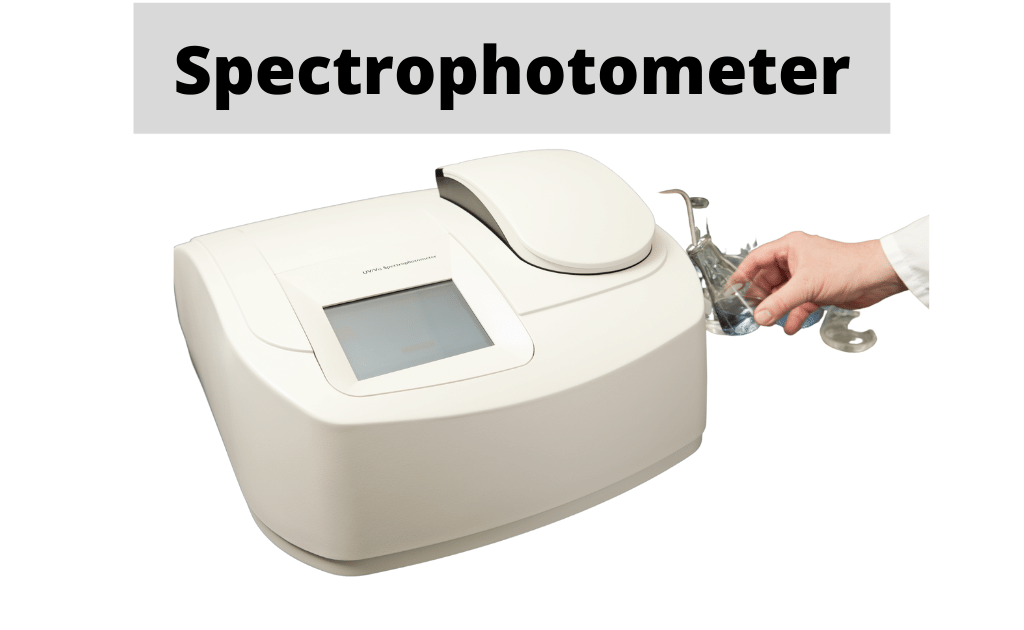Written By Adeel Abbas
Definition
Table of Contents
A spectrophotometer is a scientific instrument used to measure the amount of light that a sample absorbs or transmits at different wavelengths.
It is widely used in many fields of science, including chemistry, biochemistry, environmental science, and medicine. In this article, we will discuss the principles, working, types, and uses of spectrophotometers.

Principles of Spectrophotometer
The principle behind the spectrophotometer is based on the absorption of light by molecules. Spectrophotometry measures the amount of light that a sample absorbs at a particular wavelength.
When a beam of light passes through a sample, some of the light is absorbed by the sample, while the remaining light passes through it. The amount of light absorbed by the sample is directly proportional to the concentration of the absorbing species in the sample.
Working of Spectrophotometer
A spectrophotometer consists of a light source, a sample holder, a monochromator, a detector, and a readout device. The light source emits a broad spectrum of light that passes through the monochromator, which separates the light into its component wavelengths.
The monochromatic light is then directed through the sample, which absorbs some of the light at specific wavelengths. The detector measures the amount of light that passes through the sample, and the readout device displays the results.
Parts of a Spectrophotometer and Their Uses
- Light source: A spectrophotometer uses a light source to generate a beam of light that passes through a sample. Common light sources include tungsten-halogen bulbs, deuterium lamps, and xenon lamps. The light source should be stable and produce a consistent intensity of light.
- Monochromator: A monochromator is a device that separates light into its component wavelengths. This is accomplished using a prism or a diffraction grating. The monochromator allows the user to select a specific wavelength of light to use for the measurement.
- Sample holder: The sample holder is a container that holds the sample being analyzed. Sample holders can be cuvettes, test tubes, or even solid samples. It is important that the sample holder is clean and free of contaminants that could interfere with the measurement.
- Detector: The detector is a device that measures the intensity of light after it has passed through the sample. There are various types of detectors used in spectrophotometers, including photodiodes, photomultiplier tubes, and charge-coupled devices (CCDs).
- Data display and analysis: The output from the detector is typically displayed on a screen or computer monitor. The user can then analyze the data to determine the concentration of the sample or to identify specific substances in the sample.
Types of Spectrophotometers
- UV-Visible Spectrophotometer: UV-Visible spectrophotometers are used to measure the absorption or transmission of light in the ultraviolet and visible regions of the electromagnetic spectrum. These instruments are commonly used in analytical chemistry and biochemistry.
- Infrared (IR) Spectrophotometer: IR spectrophotometers are used to measure the absorption or transmission of light in the infrared region of the electromagnetic spectrum. These instruments are commonly used in organic chemistry to identify functional groups in molecules.
- Fluorescence Spectrophotometer: Fluorescence spectrophotometers are used to measure the fluorescence of a sample. These instruments are commonly used in biochemistry and molecular biology to detect and quantify fluorescent molecules.
Uses of Spectrophotometers
- Quantitative analysis: Spectrophotometers are used to measure the concentration of a sample. This is accomplished by measuring the amount of light absorbed or transmitted by the sample.
- Qualitative analysis: Spectrophotometers can be used to identify specific substances in a sample based on their unique absorption or transmission spectra.
- Kinetic studies: Spectrophotometers can be used to monitor the progress of a chemical reaction over time. This is accomplished by measuring the change in absorbance or transmission of light as the reaction proceeds.
- Biochemical assays: Spectrophotometers are commonly used in biochemical assays to measure enzyme activity or to detect specific biomolecules such as proteins, nucleic acids, and carbohydrates.
Spectrophotometry is a powerful analytical technique that is widely used in many fields of science. By measuring the amount of light absorbed or transmitted by a sample, spectrophotometers provide valuable information about the chemical and physical properties of the sample. With different types of spectrophotometers available, scientists can choose the most appropriate instrument for their specific research needs.